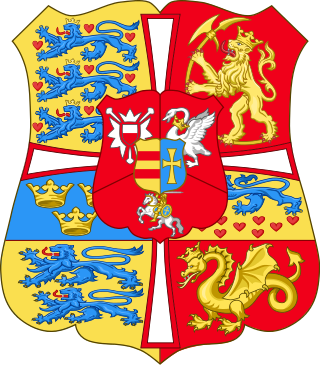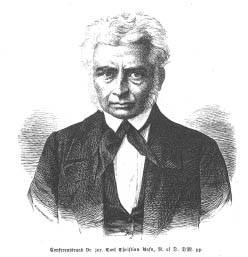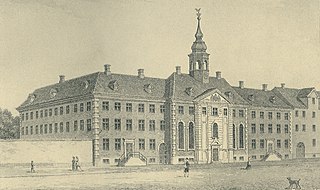This article may be expanded with text translated from the corresponding article in Danish. (June 2023)Click [show] for important translation instructions.
|
Det Danske Klasselotteri is a state-owned lottery in Denmark.
This article may be expanded with text translated from the corresponding article in Danish. (June 2023)Click [show] for important translation instructions.
|
Det Danske Klasselotteri is a state-owned lottery in Denmark.
The lottery was launched as the Royal Copenhagen Class Lottery by the Royal Orphanage (Det Kongelige Opfostringshjem) and authorized by Frederick V by royal resolution of 29 June 1753. [1] The first lottery draw took place on 25 February 1754 at Charlottenborg Palace on Kongens Nytorv.
The Royal Orphanage was in 1771 deprived of its royal warrant by Johann Friedrich Struensee. Since 1 February 1771 it has been organized by the Danish government. [2] Eggert Balthazar-Christensen (1885) was appointed as managing director of the lottery in 1936. It was based at Suomisvej 2 in 1950. [3]
In 1921, it was converted into an aktieselskab under the name Danske Klasselotteri A/S. [1]
In 2006, Det Danske Klasselotteri generated total revenues of DKK 650 million.
Two lotteries are arranged each year, one in April and one in October. Each lottery is divided into monthly renewals and draws (classes). 1/1, 1/2, 1/4 and 1/8 lottery tickets are available. The prize fund consists of 65% of the stakes. [1]

Frederick V was King of Denmark–Norway and Duke of Schleswig-Holstein from 6 August 1746 until his death in 1766. He was the son of Christian VI of Denmark and Sophie Magdalene of Brandenburg-Kulmbach.

The Royal Library in Copenhagen is the national library of Denmark and the university library of the University of Copenhagen. It is among the largest libraries in the world and the largest in the Nordic countries. In 2017, it merged with the State and University Library in Aarhus to form a combined national library. The combined library organisation is known as the Royal Danish Library.

Carl Christian Rafn was a Danish historian, translator and antiquarian. His scholarship to a large extent focused on translation of Old Norse literature and related Northern European ancient history. He was also noted for his early advocacy of the recognition of Norse colonization of North America.

Johannes Japetus Smith Steenstrup FRS(For) HFRSE was a Danish zoologist, biologist, and professor.

The Order of the Dannebrog is a Danish order of chivalry instituted in 1671 by Christian V. Until 1808, membership in the Order was limited to fifty members of noble or royal rank, who formed a single class known as White Knights to distinguish them from the Blue Knights who were members of the Order of the Elephant. In 1808, the Order was reformed and divided into four classes. The statute of the Order was amended in 1951 by a Royal Ordinance so that both men and women could be members of the Order. Today, the Order of the Dannebrog is a means of honouring and rewarding the faithful servants of the modern Danish state for meritorious civil or military service, for a particular contribution to the arts, sciences or business life, or for working for Danish interests.
Hans Basbøll is a Danish linguist and professor of Nordic languages at the University of Southern Denmark since 1975, member of Det Kongelige Danske Videnskabernes Selskab since 1991 and member of Dansk Sprognævn, the official regulatory body of Danish, in 1991–97. Basbøll has written much on various aspects of Danish, which includes The Phonology of Danish (2005), one of the most complete and authoritative sources on modern Danish phonology, and is currently working at the Center for Child Language at the University of Southern Denmark in Odense. A Festschrift honouring Basbøll was published in 2003.

Christen Christensen Raunkiær was a Danish botanist, who was a pioneer of plant ecology. He is mainly remembered for his scheme of plant strategies to survive an unfavourable season and his demonstration that the relative abundance of strategies in floras largely corresponded to the Earth's climatic zones. This scheme, the Raunkiær system, is still widely used today and may be seen as a precursor of modern plant strategy schemes, e.g. J. Philip Grime's CSR system.

The Royal Danish Academy of Fine Arts has provided education in the arts for more than 250 years, playing its part in the development of the art of Denmark.

The Royal Danish Academy of Sciences and Letters (Danish: Det Kongelige Danske Videnskabernes Selskab or is a Danish academy of science. The Royal Danish Academy was established on November 13, 1742, and was created with the purpose of strengthening the position of Science in Denmark as well as promoting interdisciplinary understanding.

The Royal Danish Academy of Music, or Royal Danish Conservatory of Music, in Copenhagen is the oldest professional institution of musical education in Denmark as well as the largest, with approximately 400 students. It was established in 1867 as Kjøbenhavns Musikkonservatorium by Niels Gade – who was also the first rector –, J.P.E. Hartmann and Holger Simon Paulli on the basis of a testamentary gift from the jeweler P.W. Moldenhauer, and with inspiration from the Leipzig Conservatory and a conservatory founded by Giuseppe Siboni in Copenhagen in 1827. Carl Nielsen was a teacher in the period 1916–1919 and the rector during the last year of his life.

Knud Jessen was a Danish botanist and quaternary geologist.

The Museum of Copenhagen is the official museum of Copenhagen, Denmark, documenting the city's history from the 12th century to the present.

The Crown Artillery Regiment was an artillery regiment of the Royal Danish Army. On 1 August 1982 it was merged with the Zealand Artillery Regiment to form the King's Artillery Regiment.

Friedrich Christian Carl Heinrich Münter was a German-Danish scholar, theologian, and Bishop of Zealand from 1808 until his death. His name has also been recorded as Friederich Münter.

Jakob Langebek was a Danish historian, linguist, lexicographer, and archivist.
Events from the year 1736 in Denmark.
Michael Treschow was a Danish Supreme Court justice and prefect of Roskilde County who was ennobled by letter patent in 1812. He was the father of Frederik Treschow.

Erich Christian Werlauff was a Danish historian, librarian and professor.

Det Kongelige Vajsenhus is a private primary school in Copenhagen in Denmark. The school has around 300 students and 25 teachers. The school has the right to print Den Danske Salmebog . The school was originally a combined orphanage and school, founded by Frederick IV of Denmark in 1727, and the institution was given a number of privileges, such as the right to manage a factory and a book printing shop. From 1740, it had the right to print Bibles and psalmbooks, and during the 18th century, it was a center for Pietism in Denmark.

A Meeting in the Royal Danish Academy of Sciences and Letters is a monumental 1897 oil-on-canvas group portrait painting by Peder Severin Krøyer, depicting the membership of Royal Danish Academy of Sciences and Letters during one of its meetings in the Prince's Mansion in Copenhagen. The painting was commissioned by the Carlsberg Foundation in conjunction with the construction of its new building on H. C. Andersens Boulevard. Measuring 519.4 cm (204.5 in) wide and 266.7 cm (105.0 in) tall, it is Krøyer's largest painting.